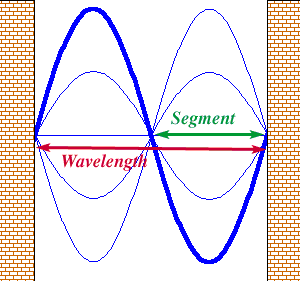Natural Frequencies of Strings
 The
vibration of a string between two fixed points can be analyzed in
terms of its natural frequencies. We will assume that the length of
the string is L and that each end of the string is a node, as was the
case in the demo that you just saw, and
as is the case in the figure shown here.
The
vibration of a string between two fixed points can be analyzed in
terms of its natural frequencies. We will assume that the length of
the string is L and that each end of the string is a node, as was the
case in the demo that you just saw, and
as is the case in the figure shown here.
We will define the term
segment (see figure) as a
closed loop. The length of a segment is thus exactly 1/2 of a
wavelength. The number of segments that will fit between the two
boundaries is equal to an integer times the number of
half-wavelengths
L = 1$\cdot$ ( $\lambda$1); L = 2$\cdot$(
$\lambda$1); L = 2$\cdot$( $\lambda$2); L = 3$\cdot$(
$\lambda$2); L = 3$\cdot$( $\lambda$3); ...
$\lambda$3); ...
In general we can write
L = n ( $\lambda$n) for n = 1, 2, 3, 4,
...
$\lambda$n) for n = 1, 2, 3, 4,
...
or

If you play a string instrument, such as a violin or a guitar or
even a piano, you are of course much more interested in the
natural frequencies. From
the velocity equation v = $\lambda$f
we obtain for the natural frequencies:

© MultiMedia Physics,
1999/2000
 The
vibration of a string between two fixed points can be analyzed in
terms of its natural frequencies. We will assume that the length of
the string is L and that each end of the string is a node, as was the
case in the demo that you just saw, and
as is the case in the figure shown here.
The
vibration of a string between two fixed points can be analyzed in
terms of its natural frequencies. We will assume that the length of
the string is L and that each end of the string is a node, as was the
case in the demo that you just saw, and
as is the case in the figure shown here.
